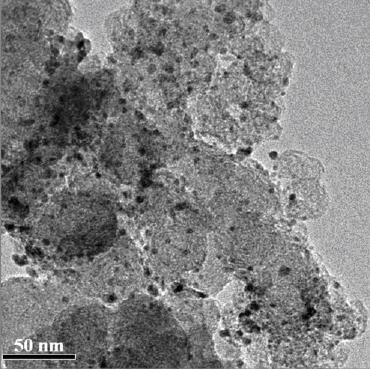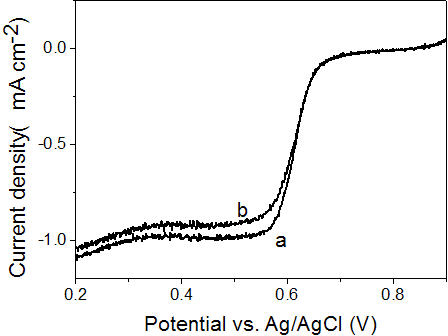Method for preparing high-alloying carbon-supported PdFe nanocatalyst by in-situ reduction method
A nano-catalyst, alloyed carbon technology, applied in metal/metal oxide/metal hydroxide catalysts, physical/chemical process catalysts, chemical instruments and methods, etc. Uniformity, uneven atomic distribution and other problems, to achieve the effect of high degree of alloying
- Summary
- Abstract
- Description
- Claims
- Application Information
AI Technical Summary
Problems solved by technology
Method used
Image
Examples
example 1
[0030] The method for preparing high-alloyed carbon-supported PdFe nano-catalysts by in-situ reduction method comprises the following steps:
[0031] 1. Weigh 60 mg of Vulcan XC-72R activated carbon powder from Cabot Company, add 3.0 ml of 0.05 mol / L K to adjust the pH value to 1.0 ~ 6.0 2 PdCl 4 Solution, mechanically stirred or ultrasonically oscillated, add 2.0 ml 0.05 mol / L K at a pH of 1.0 to 6.0 at 30 to 100°C 3 Fe(CN)6 Solution, mechanically stirred for 2 to 72 hours to make the mixture uniform.
[0032] 2. At room temperature (25°C), slowly add excess reducing agent solution (NaBH 4 ), and mechanically stirred for 1 hour to completely react the palladium ferricyanide precursor with the reducing agent.
[0033] 3. After washing with water several times, check with silver nitrate solution until there is no chloride ion in the eluate. in N 2 Drying at 50°C under the same conditions can produce Pd with a metal loading of 20% and a PdFe atomic ratio of 3:2. 3 Fe 2 / C...
example 2
[0035] The method for preparing high-alloyed carbon-supported PdFe nano-catalysts by in-situ reduction method comprises the following steps:
[0036] 1. Weigh 60 mg of carbon nanotubes (CNTs) with a diameter of 10-20 nm, and add 3.0 ml of 0.05 mol / L K to adjust the pH value to 1.0 ~ 6.0 2 PdCl 4 Solution, mechanically stirred or ultrasonically oscillated, add 2.0 ml 0.05 mol / L K at a pH of 1.0 to 6.0 at 30 to 100°C 3 Fe(CN) 6 Solution, mechanically stirred for 2 to 72 hours to make the mixture uniform.
[0037] 2. At room temperature (25°C), slowly add excess reducing agent solution (NaBH 4 ), and mechanically stirred for 1 hour to completely react the palladium ferricyanide precursor with the reducing agent.
[0038] 3. After washing with water several times, check with silver nitrate solution until there is no chloride ion in the eluate. in N 2 Drying at 50°C under the same conditions can produce Pd with a metal loading of 20% and a PdFe atomic ratio of 3:2. 3 Fe 2 ...
example 3
[0040] The method for preparing high-alloyed carbon-supported PdFe nano-catalysts by in-situ reduction method comprises the following steps:
[0041] 1. Weigh 60 mg of carbon molecular sieve, add 3.0 ml of 0.05 mol / L K to adjust the pH value to 1.0 ~ 6.0 2 PdCl 4 Solution, mechanical stirring or ultrasonic vibration, at 30 ~ 100 ℃, add 1.5 mL 0.05 mol / L K 4 Fe(CN) 6 Solution, mechanically stirred for 2 to 72 hours to make the mixture uniform.
[0042] 2. At room temperature (25°C), slowly add excess reducing agent solution (NaBH 4 ), and mechanically stirred for 1 hour to completely react the palladium ferrocyanide precursor with the reducing agent.
[0043] 3. After washing with water several times, check with silver nitrate solution until there is no chloride ion in the eluate. in N 2 Drying at 50°C under the same conditions can produce graphene-supported Pd with a metal loading of 20% and a PdFe atomic ratio of 2:1. 2 Fe 1 Nanoparticle catalysts, in which the cataly...
PUM
| Property | Measurement | Unit |
|---|---|---|
| particle size | aaaaa | aaaaa |
| particle diameter | aaaaa | aaaaa |
| particle size | aaaaa | aaaaa |
Abstract
Description
Claims
Application Information
 Login to View More
Login to View More - R&D
- Intellectual Property
- Life Sciences
- Materials
- Tech Scout
- Unparalleled Data Quality
- Higher Quality Content
- 60% Fewer Hallucinations
Browse by: Latest US Patents, China's latest patents, Technical Efficacy Thesaurus, Application Domain, Technology Topic, Popular Technical Reports.
© 2025 PatSnap. All rights reserved.Legal|Privacy policy|Modern Slavery Act Transparency Statement|Sitemap|About US| Contact US: help@patsnap.com



